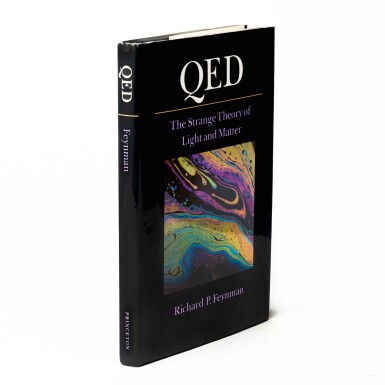[FEYNMAN, RICHARD]Sample of Gold-bearing OreEast Rand Proprietary Mines, Johannesburg, South Africa
160 x 76 x 28 mm. (6 1/4 x 3 x 1.1 in.). 186 g. (.41 lbs.).
Inscription reads: "Sample of gold bearing rock, from the deepest neutrino lab in the world. / Gift of F. Reines to R. Feynman / 1965 / Johannesburg, S. Africa"Condition reportTo request a condition report for this lot, please email science@sothebys.com.Catalogue noteA GIFT FROM ONE NOBEL LAUREATE (FREDERICK REINES) TO ANOTHER (RICHARD FEYNMAN) IN THE YEAR FEYNMAN WON THE NOBEL PRIZE, 1965
Hans Bethe, the head of the Theoretical Division at Los Alamos, was so impressed with Richard Feynman and his abilities that he appointed him leader of the Technical Computations Group, despite him being only 25 years old ("Bethe has said that he would rather lose any two other men than Feynman from this present job [at Los Alamos]" — Robert Oppenheimer, November 4, 1943). Feynman's group was tasked with solving problems related to the calculation of critical mass for the atomic bomb.
Frederick Reines was one of the scientists who worked under Feynman in the Technical Computations Group. After the war, he would stay at Los Alamos for another 14 years. However, during a sabbatical year in 1951, he decided that he wanted to pursue more fundamental physics research, choosing to work on the direct detection of the neutrino. Up until that point, the neutrino had been a purely theoretical entity, one that had famously been postulated by Wolfgang Pauli in 1930.
Reines would go on to win the Nobel Prize in Physics in 1995 for his detection of the neutrino. 30 years earlier, however, he would present this gold-bearing rock from his neutrino lab in a gold mine in South Africa, "the deepest neutrino lab in the world," as a gift to Richard Feynman in 1965, the year he won the Nobel Prize.
REFERENCES: Mehra, Jagdish. "Richard Phillips Feynman, 11 May 1918 — 15 February 1988." Biogr. Mems Fell. R. Soc. Lond. 48 (2002), p. 108.
Kropp, William, Jonas Schultz, and Henry Sobel. "Frederick Reines, March 16, 1918—August 26, 1998." National Academy of Sciences Biographical Memoir, 2009
Letter from Robert Oppenheimer to Raymond Birge Recommending Richard Feynman for a Position at Berkeley, November 4, 1943
[FEYNMAN, RICHARD]Sample of Gold-bearing OreEast Rand Proprietary Mines, Johannesburg, South Africa
160 x 76 x 28 mm. (6 1/4 x 3 x 1.1 in.). 186 g. (.41 lbs.).
Inscription reads: "Sample of gold bearing rock, from the deepest neutrino lab in the world. / Gift of F. Reines to R. Feynman / 1965 / Johannesburg, S. Africa"Condition reportTo request a condition report for this lot, please email science@sothebys.com.Catalogue noteA GIFT FROM ONE NOBEL LAUREATE (FREDERICK REINES) TO ANOTHER (RICHARD FEYNMAN) IN THE YEAR FEYNMAN WON THE NOBEL PRIZE, 1965
Hans Bethe, the head of the Theoretical Division at Los Alamos, was so impressed with Richard Feynman and his abilities that he appointed him leader of the Technical Computations Group, despite him being only 25 years old ("Bethe has said that he would rather lose any two other men than Feynman from this present job [at Los Alamos]" — Robert Oppenheimer, November 4, 1943). Feynman's group was tasked with solving problems related to the calculation of critical mass for the atomic bomb.
Frederick Reines was one of the scientists who worked under Feynman in the Technical Computations Group. After the war, he would stay at Los Alamos for another 14 years. However, during a sabbatical year in 1951, he decided that he wanted to pursue more fundamental physics research, choosing to work on the direct detection of the neutrino. Up until that point, the neutrino had been a purely theoretical entity, one that had famously been postulated by Wolfgang Pauli in 1930.
Reines would go on to win the Nobel Prize in Physics in 1995 for his detection of the neutrino. 30 years earlier, however, he would present this gold-bearing rock from his neutrino lab in a gold mine in South Africa, "the deepest neutrino lab in the world," as a gift to Richard Feynman in 1965, the year he won the Nobel Prize.
REFERENCES: Mehra, Jagdish. "Richard Phillips Feynman, 11 May 1918 — 15 February 1988." Biogr. Mems Fell. R. Soc. Lond. 48 (2002), p. 108.
Kropp, William, Jonas Schultz, and Henry Sobel. "Frederick Reines, March 16, 1918—August 26, 1998." National Academy of Sciences Biographical Memoir, 2009
Letter from Robert Oppenheimer to Raymond Birge Recommending Richard Feynman for a Position at Berkeley, November 4, 1943















Testen Sie LotSearch und seine Premium-Features 7 Tage - ohne Kosten!
Lassen Sie sich automatisch über neue Objekte in kommenden Auktionen benachrichtigen.
Suchauftrag anlegen